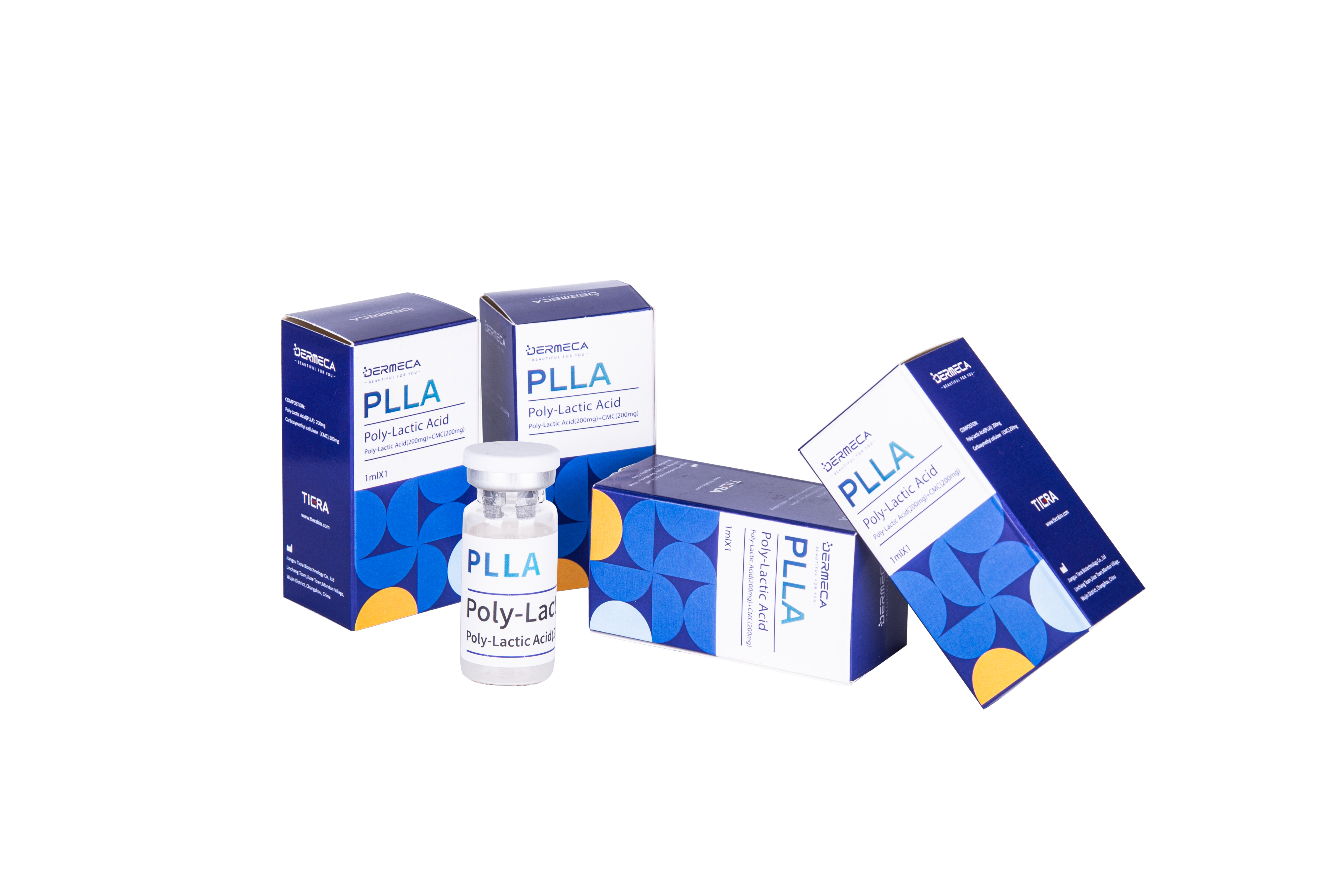PLLA ทำอะไรกับผิวหนัง?
กรดโพลีแลคติก หรือ PLLA ทำงานต่างจากสารเติมเต็มทั่วไปโดยกระตุ้นกลไกการซ่อมแซมผิวของร่างกายเอง แทนที่จะเพียงแค่เติมริ้วรอยให้ตื้นขึ้น ในขณะที่สารเติมเต็มไฮยาลูโรนิกแอซิดให้ผลหลักจากการกักเก็บน้ำเพื่อเพิ่มปริมาตรทันทีนั้น PLLA จะสร้างโครงสร้างขนาดเล็กใต้ผิวหนัง ซึ่งดึงดูดเซลล์ไฟโบรบลาสต์ เซลล์เหล่านี้จะเริ่มทำงานในการสร้างชั้นคอลลาเจนและอีลาสตินขึ้นมาใหม่ตามธรรมชาติ การศึกษาที่ตีพิมพ์ในวารสาร Journal of Cosmetic Dermatology เมื่อปี 2023 พบข้อมูลที่น่าประทับใจอย่างหนึ่งคือ ผู้ที่ได้รับการรักษาด้วย PLLA มีความหนาแน่นของคอลลาเจนเพิ่มขึ้นประมาณสองในสามภายในเวลาเพียงครึ่งปี ผลลัพธ์ในลักษณะนี้สมเหตุสมผลเมื่อพิจารณาว่า PLLA สนับสนุนกระบวนการฟื้นฟูตามธรรมชาติของร่างกาย แทนที่จะเพียงแค่ปกปิดสัญญาณของความชราอย่างชั่วคราว
กลไกการกระตุ้นการสร้างคอลลาเจนของ PLLA
กระบวนการสังเคราะห์คอลลาเจนของ PLLA เกิดขึ้นในสามระยะ:
- การตอบสนองเชิงอักเสบ : อนุภาคที่ย่อยสลายได้กระตุ้นมาโครฟาจ ทำให้ปล่อยแฟกเตอร์การเจริญเติบโต
- การกระตุ้นไฟโบรบลาสต์ : ไฟโบรบลาสต์จะเคลื่อนที่เข้าสู่พื้นที่ที่ทำการรักษา พร้อมสร้างคอลลาเจนชนิดที่ I ขึ้นใหม่
- การปรับโครงสร้างใหม่ : เส้นใยคอลลาเจนจัดเรียงตัวใหม่เป็นโครงตาข่ายคล้ายลวดลายตาข่าย ช่วยเพิ่มความยืดหยุ่นและความหนาของผิวหนัง
กลไกนี้อธิบายได้ว่าทำไมพื้นที่ที่ได้รับการรักษาด้วย PLLA จึงแสดงผลลัพธ์ 18-24% ที่ดีขึ้น ในคะแนนความยืดหยุ่นของผิวเมื่อเทียบกับฟิลเลอร์ประเภทไม่กระตุ้นชีวภาพ (Aesthetic Surgery Journal, 2022)
การออกฤทธิ์อย่างค่อยเป็นค่อยไปและการปรับปรุงด้านความงามในระยะยาว
| ลักษณะเฉพาะ | ฟิลเลอร์ PLLA | ฟิลเลอร์ HA แบบดั้งเดิม |
|---|---|---|
| ช่วงเวลาที่เห็นผลลัพธ์ | 4-6 สัปดาห์ (แบบค่อยเป็นค่อยไป) | ทันที (24-48 ชั่วโมง) |
| การ กลับ กลับ สร้าง คอลลาเจน | 4-6 เดือน | ไม่มี |
| ระยะเวลาเฉลี่ย | 25-36 เดือน | 6-18 เดือน |
ผู้ป่วยรายงานว่า ความพึงพอใจ 89% จากการฟื้นฟูด้วย PLLA ที่ให้ผลลัพธ์ดูเป็นธรรมชาติในการติดตามผลหลัง 12 เดือน โดยการสร้างคอลลาเจนจะดำเนินต่อไปได้นานถึงสองปีหลังการรักษา (Dermatologic Surgery, 2023) รูปแบบผลลัพธ์ที่ค่อยเป็นค่อยไปนี้ช่วยลดความเสี่ยงจากการแก้ไขเกินขนาด ขณะเดียวกันก็ให้การปรับปรุงโครงสร้างอย่างต่อเนื่อง
ผลลัพธ์ยาวนานและประสิทธิภาพทางคลินิกของ PLLA ที่ได้รับการพิสูจน์แล้ว
หลักฐานทางคลินิกของการฟื้นฟูปริมาตรที่คงอยู่อย่างต่อเนื่อง
เมื่อพูดถึงการฟื้นฟูใบหน้า สารเติมเต็มกรดโพลีแลคติกหรือ PLLA จะทำงานแตกต่างจากผลิตภัณฑ์ส่วนใหญ่ในตลาด โดยสารเหล่านี้กระตุ้นการสร้างคอลลาเจน ซึ่งช่วยฟื้นฟูปริมาตรของใบหน้าตามกาลเวลา แทนที่จะเติมเต็มช่องว่างทันทีเพียงอย่างเดียว ตามการวิจัยที่ตีพิมพ์ในวารสาร Journal of Cosmetic Dermatology เมื่อปี 2023 ผู้ป่วยมีความเต็มบริเวณกึ่งกลางใบหน้าเพิ่มขึ้นประมาณ 78% หลังรับการรักษาไปประมาณหกเดือน และยังคงดีขึ้นต่อเนื่องอีกประมาณหนึ่งปี เนื่องจากโครงสร้างคอลลาเจนพัฒนาได้อย่างเหมาะสม ความแตกต่างสำคัญคือวิธีการทำงานของ PLLA เมื่อเทียบกับผลิตภัณฑ์กรดไฮยาลูโรนิกแบบทั่วไป แม้ว่าสารเติมเต็ม HA จะทำหน้าที่คล้ายตัวเติมช่องว่างชั่วคราวสำหรับปริมาตรที่สูญเสียไป แต่ PLLA ทำงานลึกกว่าโดยเข้าไปจัดการกับสาเหตุที่ทำให้ใบหน้าเสียรูปเมื่อเราอายุมากขึ้น มันส่งเสริมการฟื้นฟูเนื้อเยื่อจริงๆ ซึ่งคงอยู่ได้นานกว่ามาก เพราะทำงานจากภายใน แทนที่จะอยู่แค่บนผิวเผิน
อัตราความพึงพอใจของผู้ป่วยต่อการรักษาด้วย PLLA
การศึกษาเชิงยาวแสดงให้เห็นถึงความพึงพอใจของผู้ป่วยในระดับสูง โดยเกิดจากกระบวนการปรับปรุงรูปลักษณ์ที่ค่อยเป็นค่อยไปและผลลัพธ์ที่ดูเป็นธรรมชาติ กว่า 70% ของผู้ป่วยในกลุ่มตัวอย่างปี 2021 เลือกเข้ารับการรักษาซ้ำเพื่อรักษารезультат ซึ่งอัตราการรักษานี้สูงกว่าฟิลเลอร์แบบดั้งเดิมถึง 2.3 เท่า บ่งชี้ถึงความมั่นใจอย่างมากในประโยชน์ระยะยาวของ PLLA
ระยะเวลาของผลลัพธ์เมื่อเทียบกับฟิลเลอร์แบบดั้งเดิม
ขณะที่ฟิลเลอร์กรดไฮยาลูโรนิกโดยทั่วไปจำเป็นต้องเติมเต็มใหม่ทุก 6-12 เดือน แต่ผลของการกระตุ้นคอลลาเจนของ PLLA จะคงอยู่ 18-25 เดือนหลังการฉีด (Dermatologic Surgery, 2021) ระยะเวลาที่ยืดยาวนี้ช่วยลดค่าใช้จ่ายในการรักษาตลอดชีวิตลง 62% เมื่อเทียบกับสารเติมเต็มชนิดชั่วคราว (Plastic and Reconstructive Surgery Global Open, 2023) กราฟด้านล่างแสดงความแตกต่างของอายุการใช้งานระหว่างประเภทของฟิลเลอร์:
| ประเภทฟิลเลอร์ | ระยะเวลาเฉลี่ย | การเพิ่มขึ้นของคอลลาเจนที่ 12 เดือน |
|---|---|---|
| ไฮยาลูโรนิก แอซิด | 9.5 เดือน | 0% |
| แคลเซียมไฮดรอกซีอะพาไทต์ | 12 เดือน | 22% |
| Plla | 24 เดือน | 68% |
ด้วยการกระตุ้นกลไกการซ่อมแซมตามธรรมชาติของผิวหนัง PLLA จึงให้การแก้ไขโครงสร้างที่คงทนยาวนานกว่าการเติมเต็มปริมาตรแบบเฉยๆ
PLLA เทียบกับกรดไฮยาลูโรนิกและสารเติมเต็มผิวหนังอื่น ๆ: ความแตกต่างที่สำคัญ
การออกฤทธิ์กระตุ้นชีวภาพของ PLLA เทียบกับการเติมปริมาตรแบบชั่วคราว
สารเติมเต็มผิวหนังชนิด PLLA ทำงานต่างจากตัวเลือกทั่วไป เพราะช่วยกระตุ้นการผลิตคอลลาเจน แทนที่จะเพียงแค่ดันเนื้อเยื่อให้แยกออกจากกัน การวิจัยตลาดแสดงให้เห็นว่าความนิยมของสารชีวภาพเหล่านี้เพิ่มขึ้นประมาณ 22% ตั้งแต่ปี 2024 เนื่องจากผู้คนเริ่มมองหาทางแก้ไขสำหรับการสูญเสียคอลลาเจนตามธรรมชาติที่เกิดจากการแก่ตัว สารเติมเต็มกรดไฮยาลูโรนิกทำงานโดยการดึงน้ำเข้าสู่ผิวหนังเพื่อสร้างความอิ่มตัว แต่ผลลัพธ์นี้อยู่ได้ไม่นานและมักต้องทำซ้ำหลายครั้ง ผลลัพธ์จาก HA นั้นเห็นได้ทันที ในขณะที่ PLLA ต้องใช้เวลาในการสร้างคอลลาเจนอย่างค่อยเป็นค่อยไปประมาณ 6 ถึง 12 สัปดาห์ ผู้ป่วยส่วนใหญ่พบว่าประโยชน์จาก PLLA สามารถคงอยู่ได้นานเกือบสองปี ก่อนที่จะต้องรับการรักษาอีกครั้ง ทำให้เป็นการลงทุนระยะยาวเมื่อเทียบกับทางเลือกอื่น ๆ ในตลาดปัจจุบัน
การเผาผลาญและความปลอดภัย: เหตุใดโพลีแลคติกแอซิดจึงมีความเข้ากันได้ทางชีวภาพ
เหตุผลที่พีแอลแอลเอ (PLLA) ถือว่าปลอดภัยนั้นเกี่ยวข้องกับวิธีการที่มันสลายตัวเป็นกรดแลคติก ซึ่งเป็นสารที่ร่างกายของเราผลิตขึ้นตามธรรมชาติในกระบวนการเมแทบอลิซึมปกติ ส่วนฟิลเลอร์อื่นๆ ส่วนใหญ่จำเป็นต้องใช้ตัวทำลายเฉพาะ เช่น ไฮยาลูโรนิเดส เมื่อนำไปใช้ร่วมกับกรดไฮยาลูโรนิก แต่พีแอลแอลเอมีกลไกการทำงานที่แตกต่างออกไป เพราะมันจะรวมตัวเข้ากับเนื้อเยื่อโดยรอบ แทนที่จะคงอยู่ในร่างกายในฐานะสิ่งแปลกปลอม ซึ่งหมายความว่าระบบภูมิคุ้มกันของเรานั้นไม่ตอบสนองต่อวัสดุนี้เมื่อเวลาผ่านไป เนื่องจากคุณสมบัตินี้ เราจึงพบปัญหาน้อยลง เช่น ก้อนแข็งเล็กๆ ที่เรียกว่า แกรนูลอม่า ซึ่งอาจเกิดขึ้นใต้ผิวหนัง หรือปัญหาการอักเสบที่เรื้อรัง สำหรับผู้ที่มีผิวบอบบาง หรือผู้ที่มีภาวะภูมิคุ้มกันผิดปกติ พีแอลแอลเอจึงเป็นทางเลือกที่ดีกว่าเมื่อเทียบกับผลิตภัณฑ์อื่นๆ จำนวนมากที่มีอยู่ในตลาดปัจจุบัน
แนวโน้มการใช้ฟิลเลอร์เชิงชีวภาพในวงการเวชศาสตร์ความงามสมัยใหม่
แพทย์จำนวนมากขึ้นหันมาใช้ฟิลเลอร์ชีวภาพ เช่น PLLA แทนผลิตภัณฑ์เพิ่มวอลลุ่มทั่วไป เนื่องจากสารเติมเต็มชนิดใหม่เหล่านี้ทำหน้าที่สองอย่างพร้อมกัน นั่นคือ ฟื้นฟูโครงสร้างใบหน้าและกระตุ้นกระบวนการฟื้นฟูของผิว จากการสำรวจเมื่อเร็วๆ นี้เมื่อประมาณปี 2024 พบว่าบุคลากรทางการแพทย์ประมาณ 6 ใน 10 คนเริ่มให้ความสำคัญกับการฉีดกระตุ้นคอลลาเจนเป็นอันดับแรกในการรักษาปัญหาริ้วรอยกลางใบหน้าและการปรับรูปหน้า นี่ถือเป็นการเปลี่ยนแปลงแนวคิดที่แท้จริงในวงการนี้ ซึ่งมีความสนใจเพิ่มขึ้นในแนวทางที่สอดคล้องกับการทำงานของผิวตามธรรมชาติ ไม่ใช่แค่ปกปิดริ้วรอยแห่งวัย
การประยุกต์ใช้ทางคลินิกในการฟื้นฟูปริมาตรใบหน้าและการแก้ไขริ้วรอย
การใช้ PLLA ในการยกกระชับบริเวณกึ่งกลางใบหน้าและการเสริมโครงสร้าง
เมื่อพูดถึงการแก้ปัญหาการสูญเสียปริมาตรบริเวณกึ่งกลางใบหน้าขณะที่เราอายุมากขึ้น สารเติมเต็มโพลีแลคติกแอซิดหรือ PLLA มักให้ผลดีกว่าทางเลือกมาตรฐานอย่างกรดไฮยาลูโรนิก ซึ่งทำได้เพียงแค่ไปนั่งทับอยู่บนเนื้อเยื่อเท่านั้น สิ่งที่ทำให้ PLLA พิเศษคือ มันช่วยกระตุ้นให้ผิวหนังสร้างคอลลาเจนเพิ่มขึ้นตามเวลาที่ผ่านไป ช่วยฟื้นฟูโครงสร้างที่สูญเสียไปจากภายใน แทนที่จะเติมเต็มช่องว่างเพียงชั่วคราว ตามรายงานการศึกษาล่าสุดที่ตีพิมพ์ในวารสาร Plastic and Reconstructive Surgery เมื่อปี 2024 พบว่าประมาณสี่ในห้าของผู้ป่วยสังเกตเห็นการเปลี่ยนแปลงที่ชัดเจนบริเวณโหนกแก้มประมาณสามเดือนหลังได้รับการรักษา แพทย์ความงามจำนวนมากชอบแนวทางนี้ในการรักษาปัญหาแก้มตอบและริ้วรอยคล้ำใต้ตา เนื่องจากให้ผลลัพธ์ที่ดูเป็นธรรมชาติมากกว่าวิธีอื่นๆ ซึ่งบางครั้งอาจดูเต็มเกินไปหรือดูไม่เป็นธรรมชาติ
ประสิทธิภาพในการรักษาแนวริ้วรอยข้างจมูกและริ้วรอยมุมปาก
การทดสอบแสดงให้เห็นว่า PLLA สามารถลดความลึกของร่องแก้ม (nasolabial folds) ได้โดยเฉลี่ยประมาณ 32% หลังจากได้รับการรักษาเพียงสองครั้ง กลไกของผลิตภัณฑ์นี้ช่วยกระตุ้นเนื้อเยื่อ โดยทำงานร่วมกับคอลลาเจนที่มีอยู่เดิมในผิว ทำให้เหมาะสมอย่างยิ่งสำหรับการแก้ปัญหาริ้วรอยมาริโอนette (marionette lines) ที่ดื้อต่อการรักษา พื้นที่เหล่านี้มักเป็นปัญหาเพราะกล้ามเนื้อด้านล่างมีการเคลื่อนไหวอยู่ตลอดเวลา ซึ่งมักทำให้สารเติมเต็มทั่วไปไม่สามารถคงประสิทธิภาพได้ และนี่คือสิ่งหนึ่งที่ควรพิจารณาเพิ่มเติมเกี่ยวกับ PLLA เมื่อเทียบกับทางเลือกอื่นๆ ที่เพียงแค่เติมปริมาตรชั่วคราวและจำเป็นต้องเติมซ้ำทุกๆ สามเดือนหรือประมาณนั้น กลุ่มคนจำนวนไม่น้อย—ประมาณ 76% จากการศึกษาระบบหลายศูนย์เมื่อปี 2023—ยังคงมีกรามที่ชัดเจนขึ้นแม้จะผ่านมาแล้ว 18 เดือนหลังการรักษา
กรณีศึกษา: การปรับปรุงตามแนวตั้งในภาวะสูญเสียมวลไขมันที่เกี่ยวข้องกับเชื้อเอชไอวี
การวิจัยเป็นระยะเวลาสามปีได้ศึกษาเกี่ยวกับการทำงานของ PLLA ในผู้ที่มีภาวะใบหน้าเหี่ยวจากภาวะสูญเสียไขมันใต้ผิวหนัง (facial lipoatrophy) และพบว่าความหนาของผิวหนังเพิ่มขึ้นอย่างต่อเนื่อง จนถึงระดับประมาณ 8.2 มม. หลังจากสองปี ผู้ที่ได้รับการรักษามีการฟื้นคืนปริมาตรใบหน้าที่คงอยู่ยาวนาน รวมทั้งผิวหนังมีความยืดหยุ่นดีขึ้นด้วย โดยผลการทดสอบแสดงให้เห็นว่ามีการปรับปรุงค่าต่างๆ ประมาณ 23% สิ่งที่ทำให้ PLLA โดดเด่นคือ มันกระตุ้นการสร้างคอลลาเจนโดยตรงในขณะที่ปรับโครงสร้างชั้นผิวหนังลึก สำหรับกรณีที่การรักษาอื่นๆ ไม่ได้ผล โดยเฉพาะเมื่อมีการสูญเสียปริมาตรอย่างซับซ้อน แพทย์จำนวนมากในปัจจุบันจึงพิจารณา PLLA เป็นหนึ่งในทางเลือกที่ดีที่สุด
คำถามที่พบบ่อย
กรดโพลีแลคติก (PLLA) คืออะไร
กรดโพลีแลคติก (PLLA) เป็นสารที่สามารถย่อยสลายได้ตามธรรมชาติ ซึ่งใช้ในสารเติมเต็มผิวหนังเพื่อกระตุ้นการผลิตคอลลาเจนตามธรรมชาติของผิวหนัง ส่งเสริมการฟื้นฟูสภาพผิวในระยะยาว
PLLA แตกต่างจากสารเติมเต็มไฮยาลูโรนิกแอซิดอย่างไร
PLLA กระตุ้นการผลิตคอลลาเจนเพื่อเพิ่มปริมาตรอย่างค่อยเป็นค่อยไป ในขณะที่สารเติมเต็มกรดไฮยาลูโรนิกให้ผลการเพิ่มปริมาตรทันทีโดยการกักเก็บน้ำไว้ในผิวหนัง
PLLA ปลอดภัยสำหรับผิวบอบบางหรือไม่
ใช่ PLLA ถือว่าปลอดภัยเนื่องจากสามารถรวมตัวเข้ากับเนื้อเยื่อโดยรอบและสลายตัวเป็นกรดแลคติกตามธรรมชาติ ซึ่งช่วยลดการตอบสนองของระบบภูมิคุ้มกัน
ผลลัพธ์ของ PLLA อยู่ได้นานแค่ไหน
ผลลัพธ์ของ PLLA สามารถอยู่ได้นานประมาณ 18 ถึง 25 เดือนหลังการฉีด ให้ผลการปรับโครงสร้างระยะยาวที่ดีกว่าสารเติมเต็มแบบดั้งเดิม
สารบัญ
- PLLA ทำอะไรกับผิวหนัง?
- กลไกการกระตุ้นการสร้างคอลลาเจนของ PLLA
- การออกฤทธิ์อย่างค่อยเป็นค่อยไปและการปรับปรุงด้านความงามในระยะยาว
- ผลลัพธ์ยาวนานและประสิทธิภาพทางคลินิกของ PLLA ที่ได้รับการพิสูจน์แล้ว
- PLLA เทียบกับกรดไฮยาลูโรนิกและสารเติมเต็มผิวหนังอื่น ๆ: ความแตกต่างที่สำคัญ
- การประยุกต์ใช้ทางคลินิกในการฟื้นฟูปริมาตรใบหน้าและการแก้ไขริ้วรอย
- คำถามที่พบบ่อย


